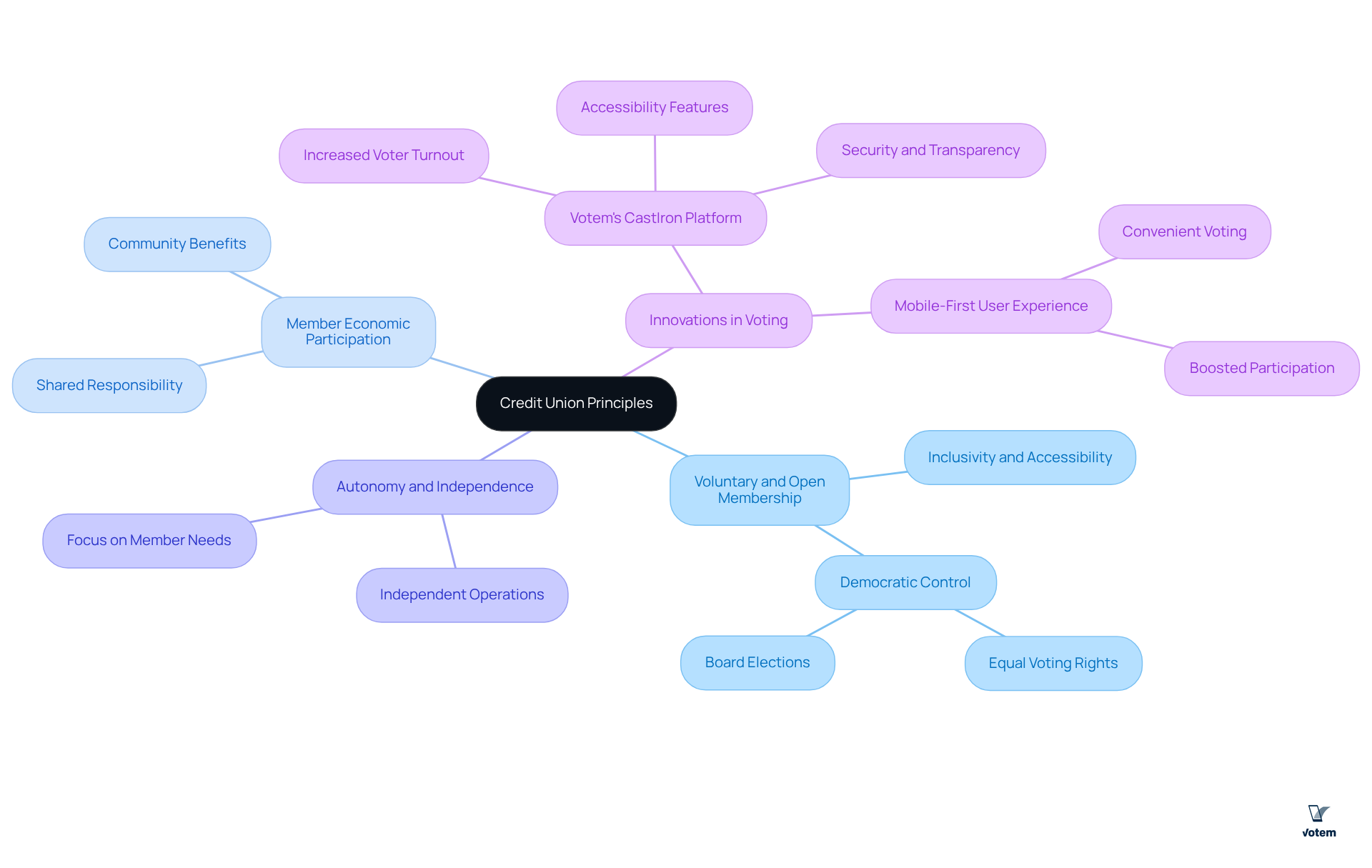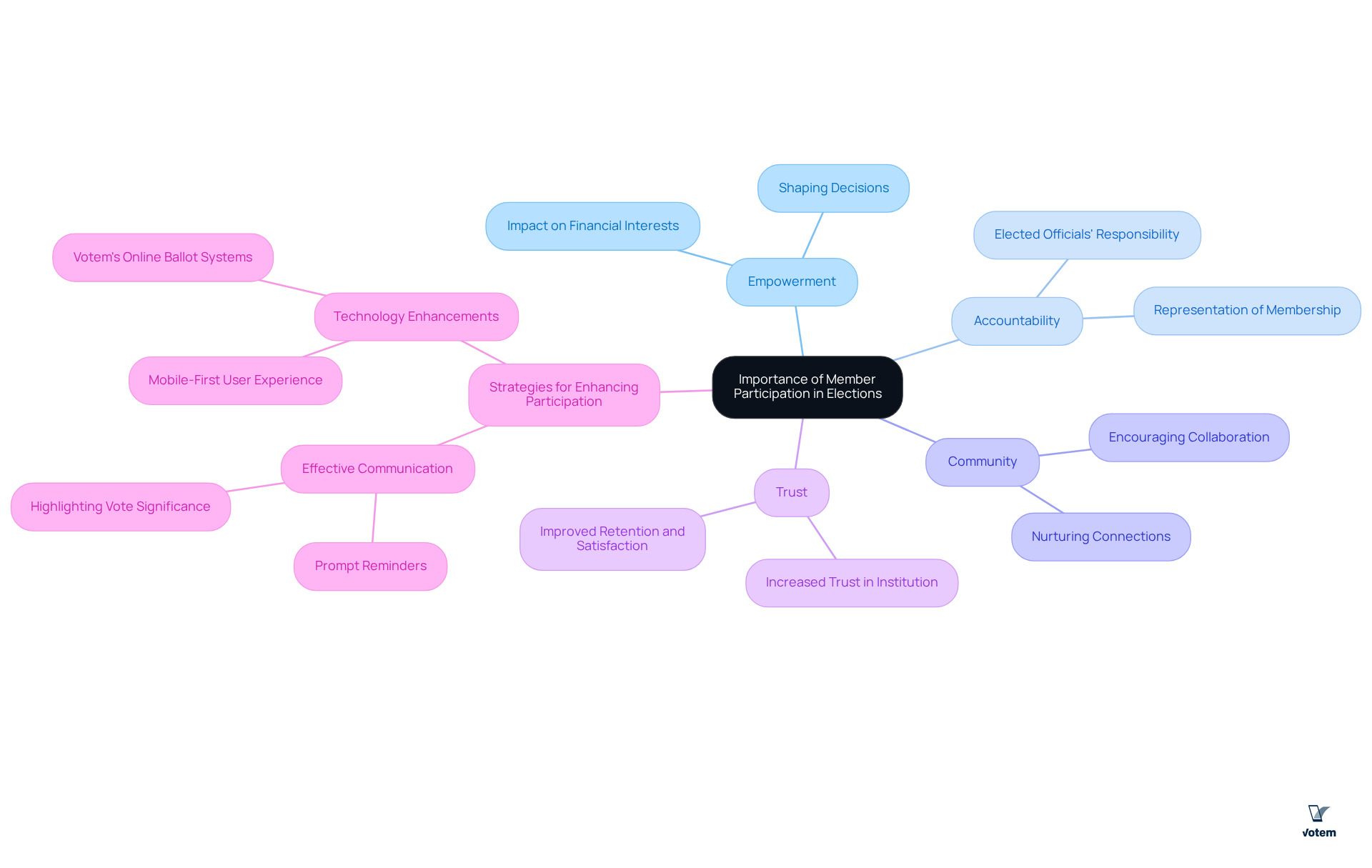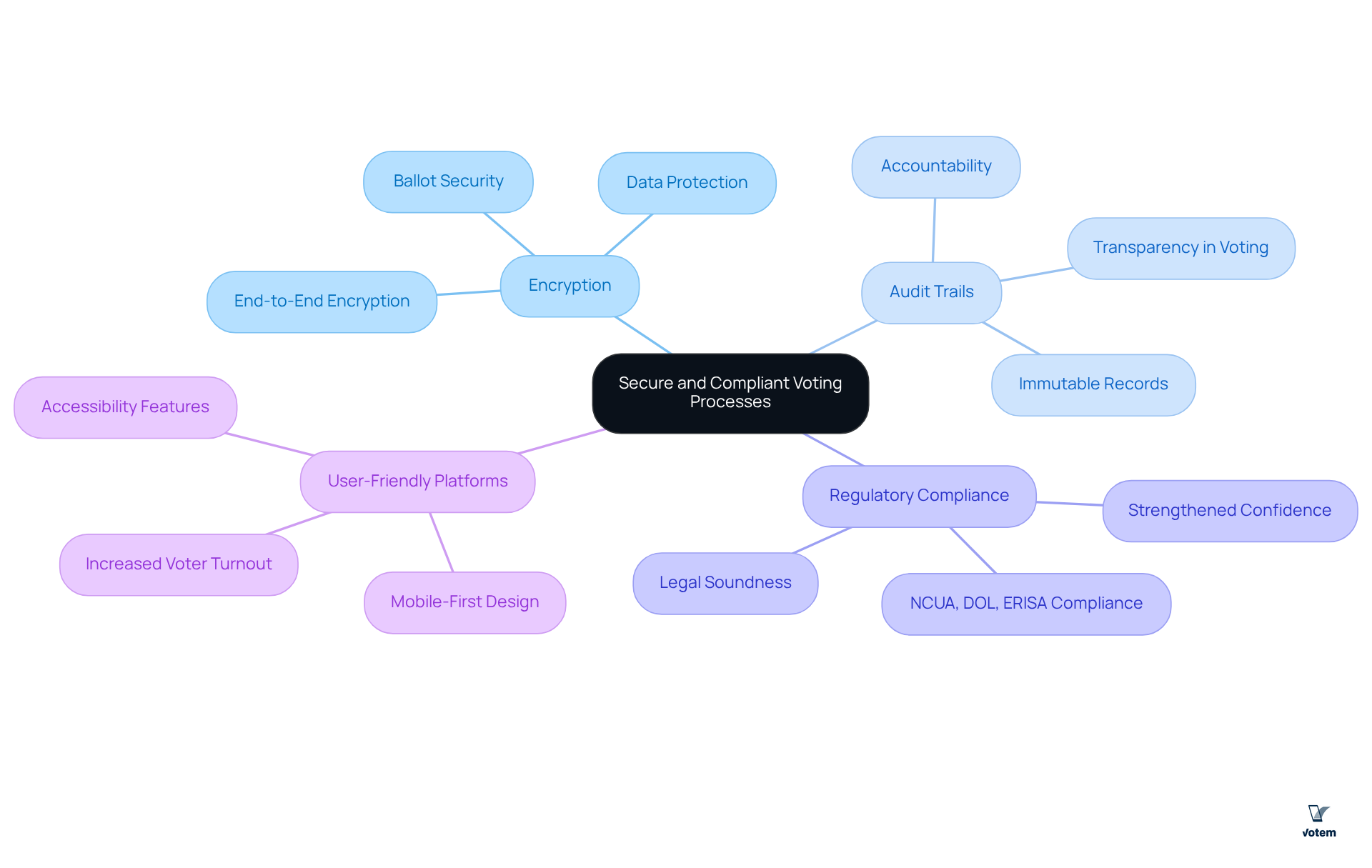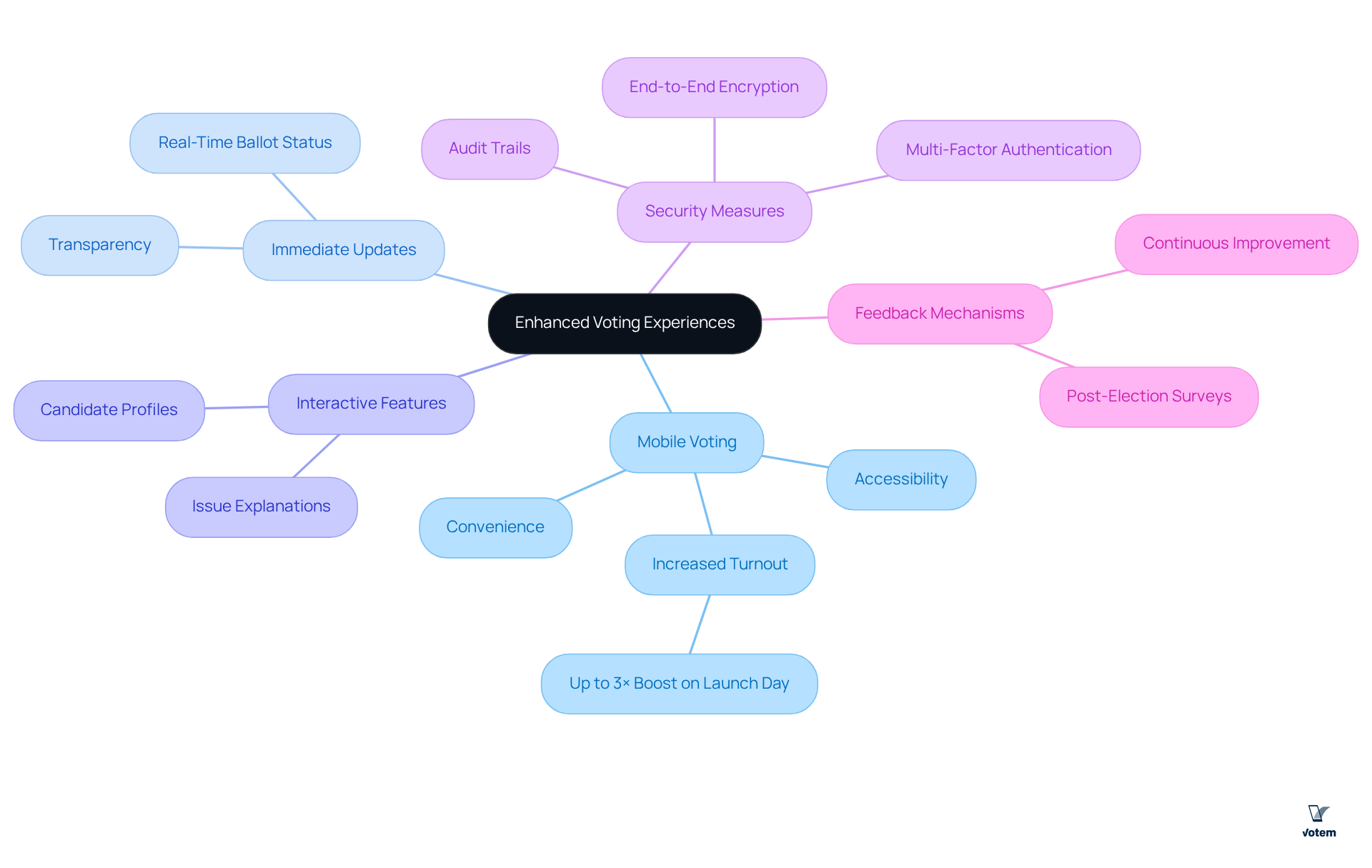Overview
This article underscores the critical importance of secure voting processes and member engagement within credit unions. It asserts that democratic governance is vital for fostering participant involvement. By detailing principles such as voluntary membership and economic participation, the article illustrates how these elements contribute to a robust democratic framework. Furthermore, it highlights the significant role of technology, particularly Votem’s platforms, in enhancing voter turnout and ensuring secure, transparent election processes.
In addition, the discussion emphasizes the necessity for union leadership to prioritize these aspects to cultivate a more engaged membership. The integration of technology not only streamlines the voting process but also builds trust among members, which is essential for their active participation. As credit unions navigate the complexities of modern governance, leveraging innovative solutions will be key to overcoming challenges and fostering a culture of participation.
Ultimately, the article calls on union leaders to take decisive action in implementing secure voting practices and engaging their members effectively. By prioritizing these strategies, they can ensure that their organizations thrive in a democratic environment, empowering members to take an active role in shaping their futures.
Introduction
Credit unions are built on a foundation of democratic principles, ensuring that every member possesses an equal voice in shaping their financial cooperative. This article explores the essential role of member engagement in credit union voting, emphasizing how secure and innovative voting processes can empower participants and enhance their overall experience.
However, a significant challenge persists: how can credit unions effectively boost voter participation and foster trust in their electoral systems while navigating the complexities of compliance and technology? By addressing these questions, we can uncover actionable insights that will strengthen the democratic process within credit unions.
Explore the Structure and Principles of Credit Unions
Credit cooperatives, owned by their participants, adhere to a distinctive set of principles aimed at fostering democratic governance and enhancing participant involvement. These key principles include:
- Voluntary and Open Membership: Credit unions invite all individuals who meet specific criteria, thereby promoting inclusivity and accessibility. Democratic control by participants is reflected in credit union voting, where each member wields an equal vote in electing the board of directors, ensuring that every voice is acknowledged, regardless of financial stake.
- Member Economic Participation: Members not only contribute to the cooperative’s services but also reap the benefits, nurturing a sense of community and shared responsibility.
- Autonomy and Independence: Operating independently from external pressures allows financial cooperatives to concentrate on the needs of those they serve.
These foundational principles shape the operational framework of cooperative financial institutions, empowering participants to actively engage in governance through credit union voting. This engagement fortifies the democratic spirit that underpins cooperative operations, ensuring that credit union voting makes participant voices integral to decision-making processes.
Data reveals that cooperative financial institutions with higher participant involvement in credit union voting often experience greater engagement and satisfaction among their members. For instance, a recent survey indicated that credit union voting with a turnout exceeding 30% reported enhanced satisfaction and loyalty among their clientele.
Industry leaders, such as Todd Harper, Board Member of the National Credit Union Administration, underscore the significance of democratic governance: “If a President can fire an NCUA Board member at any time, how will we maintain public trust in our nation’s financial services regulatory system?” This statement emphasizes the necessity for .
Moreover, Votem’s innovative online ballot solutions, particularly through its CastIron platform, have exhibited a significant increase in voter turnout and accessibility. For example, the New Mexico State Republican Party reported a remarkable surge in voter turnout, with Votem facilitating the delivery of 123,000 votes—more than double the turnout from the previous election in 2015. Additionally, testimonials from leaders like Linda McCulloch highlight the importance of Votem’s system in providing greater access for all qualified voters, including military personnel and individuals with disabilities.
By ensuring secure and transparent voting procedures, Votem fosters an environment where disputed elections are rare, further reinforcing the democratic values upheld by cooperative organizations.

Understand the Importance of Member Participation in Elections
Member involvement in credit union voting is vital, serving as the foundation of their democratic structure. Here are several compelling reasons why this engagement is essential:
- Empowerment: Voting empowers members to shape decisions that directly impact their financial interests and the strategic direction of the credit union.
- Active participation in credit union voting ensures that elected officials remain accountable, truly representing the interests of the membership.
- Credit union voting fosters a sense of community among participants, nurturing connections and encouraging collaboration within the organization.
- Increased trust in the institution can be fostered through credit union voting, as individuals recognize the significance of their votes, which leads to improved retention and satisfaction rates.
To enhance participant involvement in credit union voting, credit unions can implement effective communication strategies. Prompt reminders about upcoming elections and highlighting the significance of each vote can significantly boost engagement in credit union voting. Additionally, utilizing diverse platforms, including social media and newsletters, can further raise awareness.
Votem’s groundbreaking improve accessibility and security, facilitating participation for all individuals, including those with disabilities and military voters. As Linda McCulloch stated, “Implementing Votem’s new, modern system which allowed greater access for all qualified voters from military voters to voters with disabilities was my greatest accomplishment in office.” By leveraging Votem’s technology, financial cooperatives can ensure that credit union voting is secure and effective, ultimately enhancing participant engagement. It is also crucial to note that voter eligibility requires individuals to be at least 16 years old and in good financial standing with the cooperative. By incorporating these strategies and insights, financial cooperatives can significantly enhance member involvement in credit union voting.

Learn About Secure and Compliant Voting Processes in Credit Unions
To uphold the integrity of elections, must be implemented in credit union voting by cooperative financial institutions. This commitment is not just a necessity but a strategic imperative. Key components include:
- Encryption: Ensuring that all ballots are encrypted both in transit and at rest is essential for protecting voter privacy and preventing tampering. This level of security is crucial in maintaining the confidentiality of votes and safeguarding against unauthorized access.
- Audit Trails: Establishing an immutable audit trail is vital for verifying all votes cast, thereby enhancing transparency and trust in the election results. This feature allows credit unions to review the election process comprehensively, ensuring accountability and reliability.
- Regulatory Compliance: Adhering to regulations established by organizations like the NCUA, DOL, and ERISA is essential for ensuring that election processes are legally sound and secure. Compliance not only safeguards the organization but also strengthens confidence in the electoral system among participants.
- User-Friendly Platforms: Utilizing secure online ballot platforms, such as Votem’s CastIron, promotes easier access for participants while ensuring compliance with strict security standards. The platform’s mobile-first design can significantly boost voter turnout, making participation more convenient.
By prioritizing encryption, audit trails, and compliance, financial cooperatives can establish a reliable electoral atmosphere that promotes active participant involvement in credit union voting. This proactive approach not only enhances the electoral process but also fosters a culture of trust and integrity within the organization.

Leverage Technology for Enhanced Voting Experiences
Technology plays a pivotal role in enhancing the electoral experience through credit union voting for participants. By leveraging innovative solutions, credit unions can significantly improve engagement and satisfaction among their members. Here are several effective strategies to consider:
- Mobile Voting: Implementing Votem’s cutting-edge mobile-friendly voting platform allows members to cast their votes anytime and anywhere, greatly enhancing accessibility and convenience. This approach has the potential to boost voter turnout by up to three times on launch day, as demonstrated by Votem’s mobile-first user experience, which has led to substantial increases in voter turnout for events like the National Radio Hall of Fame.
- Immediate Updates: Utilizing technology to provide real-time updates on ballot status and outcomes keeps participants informed and engaged throughout the election process. Votem’s not only fosters trust but also encourages participation, ensuring that all stakeholders have access to verifiable data.
- Interactive Features: Integrating interactive elements, such as candidate profiles and comprehensive explanations of issues, empowers members to make well-informed decisions. This engagement can cultivate a more informed electorate and enhance satisfaction with the election process, aligning with Votem’s objective of increasing voter participation.
- Security Measures: Ensuring the integrity of the election process is paramount. Votem implements critical security measures, including end-to-end encryption and multi-factor authentication, which significantly bolster participant trust in digital elections and guarantee a reliable electoral process.
- Feedback Mechanisms: Post-election, technology can facilitate the collection of participant feedback regarding their election experience. This vital input is essential for guiding future improvements, ensuring that the election process continually meets participants’ needs.
By embracing these technological advancements, credit unions can cultivate a more engaging and efficient credit union voting process that resonates with their members. Ultimately, this leads to increased participation and greater satisfaction, positioning credit unions as leaders in electoral innovation.

Conclusion
The essence of effective credit union voting lies in fostering member engagement and ensuring secure, transparent processes. By prioritizing democratic governance, credit unions empower members to actively participate in decision-making, enhancing satisfaction and strengthening the cooperative’s foundation. The principles of inclusivity, economic participation, and autonomy are crucial to creating an environment where every member’s voice is valued.
Key insights highlighted throughout this article underscore the importance of secure voting methods, the role of technology in enhancing participation, and the necessity of compliance with regulatory standards. Innovative solutions provided by platforms like Votem demonstrate how integrating technology can lead to increased voter turnout and a more engaged membership. Furthermore, the emphasis on secure processes, including encryption and audit trails, reassures members that their votes are protected and their voices matter.
In light of these insights, it is imperative for credit unions to adopt best practices in their voting processes and leverage technology to create an inclusive and engaging electoral experience. By doing so, they uphold the democratic values that underpin their operations while fostering a sense of community and trust among members. Encouraging participation in credit union elections is not just beneficial; it is essential for the continued success and relevance of these cooperative institutions.
Frequently Asked Questions
What are the main principles of credit unions?
The main principles of credit unions include voluntary and open membership, democratic control by participants, member economic participation, and autonomy and independence.
How does credit union voting work?
In credit union voting, every member has an equal vote in electing the board of directors, ensuring that all voices are acknowledged regardless of financial stake.
What is the significance of member economic participation in credit unions?
Member economic participation allows members to contribute to the cooperative’s services and benefit from them, fostering a sense of community and shared responsibility.
Why is autonomy and independence important for credit unions?
Autonomy and independence enable credit unions to operate without external pressures, allowing them to focus on the needs of their members.
How does participant involvement in credit union voting affect member satisfaction?
Higher participant involvement in credit union voting is associated with greater engagement and satisfaction among members, with surveys indicating that a turnout exceeding 30% leads to enhanced satisfaction and loyalty.
What role does transparency and accountability play in credit union governance?
Transparency and accountability in governance are crucial for maintaining public trust in financial services, as emphasized by industry leaders like Todd Harper.
How has Votem contributed to voter turnout in credit unions?
Votem’s online ballot solutions, particularly through its CastIron platform, have significantly increased voter turnout and accessibility, as evidenced by the New Mexico State Republican Party’s experience of more than doubling voter turnout from the previous election.
What benefits does Votem’s system provide for voters?
Votem’s system ensures secure and transparent voting procedures, providing greater access for all qualified voters, including military personnel and individuals with disabilities, and fostering an environment with rare disputed elections.
List of Sources
- Explore the Structure and Principles of Credit Unions
- Credit unions present their priorities to US presidential candidates (https://thenews.coop/credit-unions-present-their-priorities-to-us-presidential-candidates)
- Trump administration removes Democratic members of credit union watchdog (https://thehill.com/homenews/administration/5252367-trump-administration-fires-credit-union)
- woccu.org (https://woccu.org/newsroom/releases/Credit_Unions_Confront_Challenge_of_Aging_Membership_on_Final_Day_of_2024_World_Credit_Union_Conference)
- US judge rules Trump illegally fired two Democratic members of credit union agency (https://reuters.com/legal/government/us-judge-rules-trump-illegally-fired-two-democratic-members-credit-union-agency-2025-07-22)
- Understand the Importance of Member Participation in Elections
- Almost 100,000 Members Vote in SECU Election (https://cusomag.com/2024/10/21/almost-100000-members-vote-in-secu-election)
- Vote Now For the 2025 Board of Directors! (https://ffcommunity.com/vote-now-for-the-2025-board-of-directors)
- Credit unions gear up for Election Day (https://americanbanker.com/creditunions/list/credit-unions-gear-up-for-election-day)
- Engaging Young Members in Credit Union Elections – ElectionBuddy (https://electionbuddy.com/blog/2024/05/01/engaging-young-members-in-credit-union-elections)
- How to communicate with members during election season (https://cuinsight.com/how-to-communicate-with-members-during-election-season)
- Learn About Secure and Compliant Voting Processes in Credit Unions
- Encryption Methods for Secret Ballots – ElectionBuddy (https://electionbuddy.com/blog/2025/03/28/encryption-methods-for-secret-ballots)
- Credit unions digital elections: secure and efficient voting (https://eligovoting.com/credit-unions-digital-elections)
- Bespoke Election & AGM Support for Credit Union Voting | UK Engage (https://uk-engage.org/credit-union-election-services)
- electionbuddy.com (https://electionbuddy.com/blog/2024/06/19/role-of-encryption-in-online-voting)
- The benefits of e-voting to Credit Unions — Aegis Outsourcing & Advisory Services, Trinidad & Tobago (https://aegistt.com/insights/the-benefits-of-e-voting-to-credit-unions)
- Leverage Technology for Enhanced Voting Experiences
- Credit unions digital elections: secure and efficient voting (https://eligovoting.com/credit-unions-digital-elections)
- surveyandballotsystems.com (https://surveyandballotsystems.com/blog/credit-unions/let-your-credit-union-members-vote-online-and-on-the-go)
- CUES eVote | CUES (https://cues.org/product-service/cuesevote-voting-software-for-credit-unions)
- Mobile Voting | Join the Movement (https://mobilevoting.org)
- Good Governance: The Benefits of Online Voting for Credit Unions | CU Management (https://cumanagement.com/articles/2024/02/good-governance-benefits-online-voting-credit-unions)

